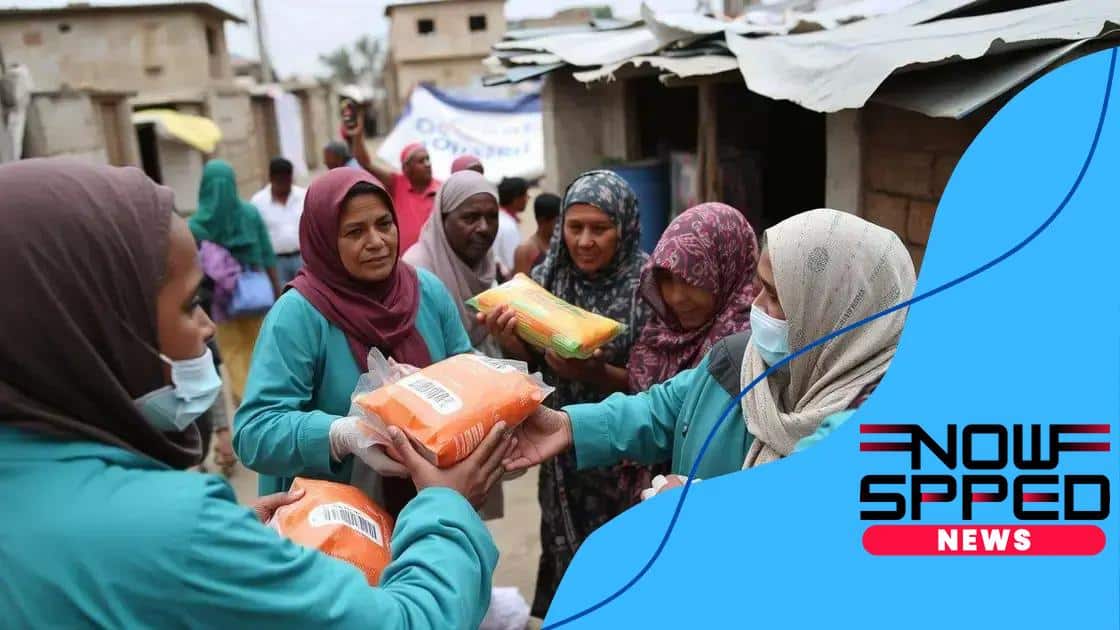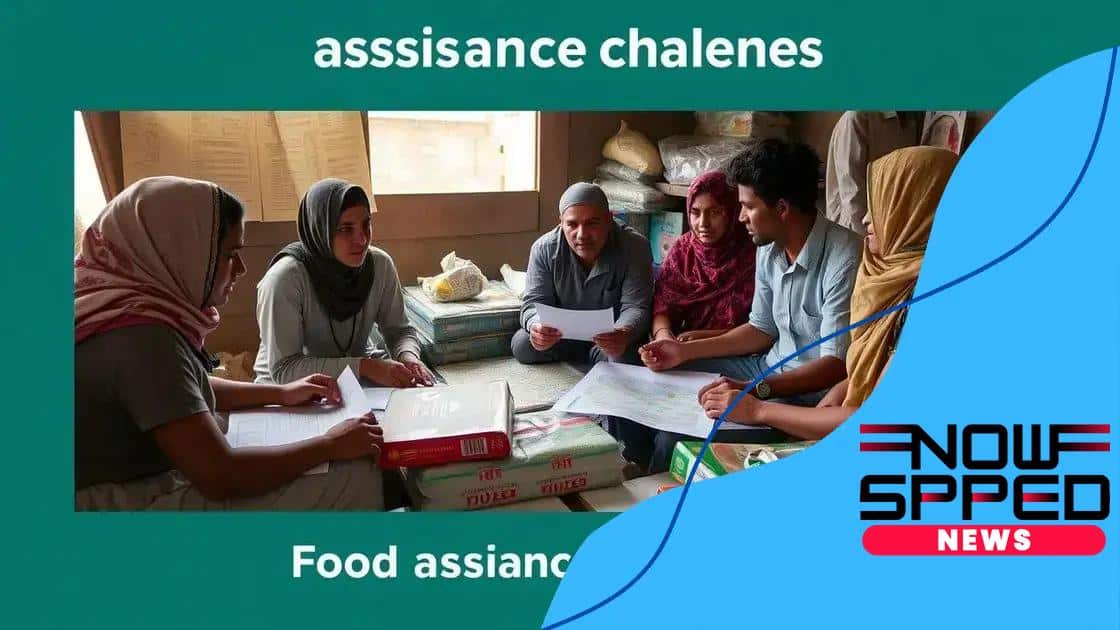Global food assistance programs responding to crises

Global food assistance programs responding to crises aim to alleviate hunger and provide nutritional support through innovative solutions, collaboration, and effective logistics, adapting to various challenges in disaster and conflict situations.
Global food assistance programs responding to crises play a crucial role in mitigating hunger during emergencies. Have you ever wondered how these programs operate and what challenges they face? Let’s explore their impact and significance.
Understanding the landscape of international food assistance
Understanding the landscape of international food assistance is vital for grasping how aid reaches those in need during crises. It encompasses various programs and organizations focused on alleviating hunger worldwide.
Many factors influence these programs, including political stability, economic conditions, and the logistical challenges of delivering aid. Often, food assistance is not just about providing meals but ensuring that individuals and families have the necessary nutritional support.
Key Players in Food Assistance
Several organizations work tirelessly to implement food assistance programs. Here are some of the most influential:
- World Food Programme (WFP)
- Food and Agriculture Organization (FAO)
- United Nations Children’s Fund (UNICEF)
- Non-governmental organizations (NGOs) like Oxfam and CARE
These entities collaborate on logistics, funding, and distribution strategies to maximize their impact.
The concept of food assistance also evolves with changing global dynamics. For instance, during the COVID-19 pandemic, organizations adapted their approaches to account for travel restrictions and safety protocols.
Challenges Facing Food Assistance Programs
Despite their efforts, food assistance programs face numerous obstacles:
- Access: Getting food to remote or conflict-affected areas can be complicated.
- Funding: Sustaining financial support is crucial for ongoing initiatives.
- Cultural Considerations: Understanding local preferences is key to effective aid.
These challenges require innovative solutions and flexibility, showcasing the resilience of these programs.
Ultimately, understanding the landscape of international food assistance involves recognizing not just the mechanics of how aid is delivered but also the dedication of those involved in the process. Effective programs not only save lives but also empower communities to rebuild and thrive.
Key organizations involved in crisis response
Several key organizations play a critical role in the crisis response landscape. Each of them contributes uniquely to providing food assistance and ensuring that help reaches those who need it most.
The World Food Programme (WFP) is one of the largest relief organizations, delivering food during emergencies and supporting communities in rebuilding their lives. Their comprehensive approach involves logistics planning and partnerships with other entities.
Notable Organizations
Other significant organizations include:
- Food and Agriculture Organization (FAO): Focuses on improving agriculture and food security globally.
- United Nations Children’s Fund (UNICEF): Works to ensure children have enough nutritious food.
- International Red Cross and Red Crescent Movement: Provides emergency support and disaster relief.
- Non-governmental organizations (NGOs): Groups like Oxfam and CARE also contribute substantially to crisis responses.
These organizations collaborate effectively, each bringing expertise to handle various challenges in food assistance. The combination of resources and knowledge helps in planning and executing aid strategies efficiently.
The importance of their roles becomes evident during crises such as natural disasters or conflicts, where the need for food becomes urgent. By coordinating rapidly, these organizations aim to prevent starvation and ensure everyone has access to essential nutrients.
Collaborative Efforts
Collaboration is a key aspect of effective crisis response. Organizations often partner with local governments and communities to implement targeted solutions. This ensures that the supplied aid aligns with local needs and preferences.
In crises, the collective knowledge and resources of these entities are crucial. They manage logistics, distribution, and outreach, helping vulnerable populations regain stability. Their efforts not only provide immediate relief but also lay the foundation for long-term recovery.
Challenges faced by food assistance programs

Food assistance programs encounter various challenges that hinder their effectiveness during crises. Understanding these obstacles is crucial for improving the delivery of aid to those in need.
Access to remote areas is often one of the most pressing challenges. Many people in need are located in difficult-to-reach regions, especially after disasters. This creates delays in food delivery and can lead to increased hardships on populations already facing starvation.
Common Challenges
Several key challenges are frequently highlighted:
- Funding Limitations: Sustaining financial resources is essential for ongoing support. Without adequate funding, programs struggle to deliver enough food to affected populations.
- Cultural Sensitivity: Understanding local customs and dietary preferences is vital. Programs that do not cater to these factors risk wasting resources and failing to provide effective aid.
- Logistical Issues: Timing and transportation can significantly impact aid efforts. Bad weather, damaged infrastructure, or political instability can all complicate delivery.
- Coordination Challenges: Multiple organizations often operate in the same area, leading to overlaps and gaps in service. Coordinating efforts efficiently is necessary to avoid duplication and ensure comprehensive coverage.
Many food assistance programs must navigate these difficulties while still providing immediate relief in times of crisis. The delicate balance of acting swiftly while being efficient is crucial.
Furthermore, as the landscape of crises evolves due to climate change and conflict, food assistance programs must also adapt their strategies. This flexibility helps them address both immediate and long-term food security issues.
Innovative Solutions
To overcome these challenges, several innovative solutions are being implemented. For instance, utilizing technology for better logistics planning allows organizations to optimize food distribution. Additionally, fostering partnerships with local communities enhances the cultural relevance of food programs and improves acceptance.
Ultimately, addressing the challenges faced by food assistance programs is a continuous effort. By identifying and solving these issues, organizations can improve their response times and increase the effectiveness of their aid strategies.
The effectiveness of food aid in different crises
The effectiveness of food aid can vary significantly depending on the type of crisis being faced. Different circumstances require tailored approaches to ensure that the aid provided meets the specific needs of affected populations.
In natural disasters, such as earthquakes or hurricanes, the need for immediate food assistance is urgent. Organizations often respond quickly by delivering ready-to-eat meals and supplies. The rapid response is essential in preventing starvation and maintaining health among affected communities.
Food Aid in Natural Disasters
Key features of effective food aid in these situations include:
- Speed of Delivery: Rapid mobilization ensures that food reaches those in need in a timely manner.
- Diverse Food Options: Providing a variety of foods caters to different dietary needs and preferences.
- Coordination with Local Authorities: Working closely with local governments enhances logistics and distribution efforts.
During conflicts, the situation changes. Food aid becomes complicated by security issues and ongoing violence. Aid organizations often face challenges in accessing those most in need. In these scenarios, programs focus on local partnerships to ensure safe delivery.
Food Aid in Conflict Zones
Effective strategies in conflict zones include:
- Monitoring and Evaluation: Keeping track of where food goes ensures it reaches intended beneficiaries.
- Community Engagement: Involving local communities helps to safeguard aid and encourages trust.
- Adaptability: Programs must be flexible to adjust to changing conditions on the ground.
The results of food aid vary, with some programs achieving significant success in mitigating hunger while others struggle. Evaluating the impact of these efforts is essential. Data collection and feedback from communities can guide future interventions.
In health crises, such as pandemics, food support focuses on nutrition to strengthen immune systems. Distributing nutritious foods becomes critical to maintaining public health during these times. Collaboration with health organizations can amplify the success of food aid.
Food Aid During Health Crises
Key factors for effectiveness during health crises include:
- Nutritional Quality: Prioritizing healthy foods can help strengthen community resilience.
- Education on Nutrition: Providing information on healthy eating supports long-term health.
- Integration with Health Services: Combining food assistance with health services maximizes for effectiveness.
Success in food aid largely depends on understanding the specific needs of each crisis situation. By adjusting strategies based on crisis type, aid programs can ensure more effective support for the communities they serve.
Innovative solutions for improving food assistance
Innovative solutions are essential for improving food assistance programs. As needs evolve, so must the strategies to effectively deliver aid to those affected by crises. These solutions often focus on enhancing efficiency, accessibility, and sustainability.
Technology plays a pivotal role in transforming food assistance. Digital platforms can streamline logistics and improve the distribution processes. For instance, using mobile apps for food tracking can ensure that supplies reach the intended recipients quickly.
Key Innovations in Food Assistance
Here are some innovative approaches that are being utilized:
- Blockchain Technology: This technology helps enhance transparency in supply chains, allowing organizations to track food from source to delivery.
- Data Analytics: Analyzing data from past crises can help organizations predict needs and allocate resources more effectively.
- Community-Based Solutions: Engaging local communities in the planning and implementation of food programs ensures that the aid meets their specific needs.
- Urban Agriculture Initiatives: Supporting urban farming projects helps communities grow their own food, increasing self-sufficiency.
Incorporating these innovations not only improves the efficiency of food assistance but also builds resilience in communities. For example, when communities gain knowledge about local food production, they become less reliant on external help.
Partnerships and Collaborations
Collaboration between various sectors is another innovative solution. By partnering with tech companies, governments, and local organizations, food assistance programs can leverage diverse resources. This leads to the development of more holistic strategies that address both immediate and long-term food security issues.
Moreover, cross-sector partnerships can create educational campaigns to raise awareness about nutrition and responsible consumption. By informing communities, they can make better choices about their food, further enhancing the impact of food assistance.
Ultimately, the goal of these innovative solutions is to create a more responsive and adaptable system for food assistance. Through technology, community involvement, and partnerships, programs can effectively meet the needs of individuals facing food insecurity.
FAQ – Frequently Asked Questions about Food Assistance Programs
What are the main goals of food assistance programs?
The main goals are to alleviate hunger, provide nutritional support, and assist communities during crises and emergencies.
How do organizations ensure food aid reaches those in need?
Organizations use logistics, data analytics, and partnerships with local communities to effectively distribute food and monitor delivery.
What challenges do food assistance programs face?
Common challenges include access to remote areas, funding limitations, and coordinating efforts among multiple organizations.
How can technology improve food assistance efforts?
Technology enhances logistics, enables better tracking of food supplies, and facilitates communication between organizations and beneficiaries.





